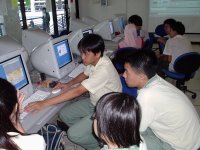Will or will not media influence learning? The Clark/Kozma debate
 Clark, the skeptic, did not believe that the media will influence student’s achievements. Using the metaphor of a delivery truck, he argued that the media does not cause changes in our ‘nutrition’. Instead, he claimed that learning outcomes are due to the method of instructions and not the medium. He contended that we should not “continue to waste resources studying media ‘solutions’ to learning problems we don’t understand” (Shrock, 1994). On the other hand, Kozma, the advocate, posited that media can influence learning and that the medium of instruction is as important as its content. He debated that both should have a more integral relationship and not viewed as separate entities.
Clark, the skeptic, did not believe that the media will influence student’s achievements. Using the metaphor of a delivery truck, he argued that the media does not cause changes in our ‘nutrition’. Instead, he claimed that learning outcomes are due to the method of instructions and not the medium. He contended that we should not “continue to waste resources studying media ‘solutions’ to learning problems we don’t understand” (Shrock, 1994). On the other hand, Kozma, the advocate, posited that media can influence learning and that the medium of instruction is as important as its content. He debated that both should have a more integral relationship and not viewed as separate entities.The debate points to the differing roles of the media, method, learner and the instructor. Before one takes a stand, one must ensure that the instructional media and method are mutually modifiable to response to the instructional and learner outcomes. We had seen varying degrees of success with the introduction of film, radio, and television into classrooms. Each new medium seems to make claims for its ability to improve learning and classroom instruction (Clark, 1983).
Does it or does it not influence learning? That is the question.
In this sophisticated age where technology remains the buzz word, the ‘wow’ factor is needed to attract users. Students are often in awe of animations, graphics and interactive games. Research done by Kulik (1995) on the learning benefits of various media (especially computers), has shown that it is the instructional method built into the computer and not the computer itself that accounts for the learning gain. According to him, design technologies do somewhat influence student achievement.
Enhanced learning and retention can take place through the use of visual material (Dwyer & Baker, 2001). The use of the visual medium in teaching and learning is supported by research demonstrating that learner preferences and styles can be more effectively addressed (Gardner, 1993). The visual medium can be an effective tool in the teaching of certain concepts and values which textbooks would not have otherwise been able to reinforce. Subjects such as Music and Geography require resources that are visual in nature. Through technology, students are able to hear and learn the sound of Sizhu music built on the pentatonic scale, see and identify the graphical formation of a sea stack and even recognize bullying (through drama re-enactment); all these achieved in the comfort of the classroom. Some students are unable to travel beyond their homes due to financial constraints. However, their learning will not be compromised as technology is able to bring the world to them - students can visit a squatter settlement and come close to the endangered Proboscis monkey of Sarawak.
However, as technology grows, there is the fear that students might be exposed to undesirable content as they rely on information available on the Internet. Some students do not have the information literacy skills to critically analyze the information they read. The appeal of the colorful and vibrant materials on the Internet might also outshine books and journals. And if teachers themselves become too reliant on technology, one wonders what would happen should technology fail us one day. Furthermore, technology lessens face-to-face pupil-to-teacher interactions. Technology can perhaps replace content but it cannot replace skills that only teachers are able to impart.
Even though the media is effective in enhancing teaching and learning, the teacher’s role is still vital in providing advice, care and concern that technology is lacking in.
References:
Clark, R. (1983). Media will never influence learning. Educational Technology, Research and Development, 42(2), 21-29.
Dwyer, F. & Baker, R. A systematic meta-analytic assessment of the instructional effects of varied visuals on different types of educational objectives in R. E. Griffen, V.S. Williams & J. Lee (2001). Exploring the visual future: art design, science and technology. Blacksburg, VA: The International Visual Literacy Association.
Gardner, H. (1993). Multiple Intelligences: The theory in practice, New York: Basic Books.
Kozma, R. (1994). Will media influence learning? Reframing the debate. Educational Technology, Research and Development, 42(2), 7-19.
Kulik, J.A. (1985). The importance of outcome studies: A reply to Clark. Educational Communications and Technology Journal, 34 (1), pp. 381-386.
Shrock, J. (1994) Guide for educators: Critical evaluation survey. Chicago: Contemporary Books.


0 Comments:
Post a Comment
<< Home